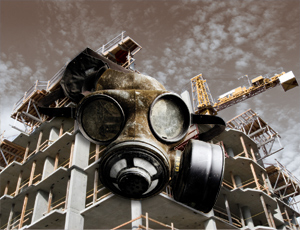Concrete groups are on tenterhooks, waiting for the U.S. Environmental Protection Agency to publish a proposed rule that aims to designate fly ash and other coal-combustion by-products as hazardous waste. The concrete sector is concerned even about the ramifications of a “hybrid” rule that would allow beneficial uses of CCBs to continue.

Major among these beneficial uses is fly ash in concrete. The ingredient, a partial replacement for portland cement, is known to increase concrete’s constructibility, durability and sustainability.
Concrete stakeholders say a hazardous-waste designation for fly ash would make it the “new asbestos” or “new lead paint,” dragging concrete into the fray. Questions would arise over the handling practices of both materials during production and casting as well as during the demolition and disposal of concrete structures.
A hazardous-waste designation for fly ash would “stigmatize its use as an ingredient in concrete, even if EPA were to focus a designation only on fly ash that is disposed rather than beneficially reused,” says Andrew T. O’Hare, vice president of regulatory affairs in Portland Cement Association’s Washington, D.C., office.
EPA’s possible action has pitted environmentalists against industry groups and threatened future building plans, including a $50-million fly-ash recycling facility.
The issue has raised many questions. Is it dangerous if someone drills a hole in concrete with sequestered fly ash? Should workers wear respirators? Are existing structures that contain sequestered fly ash a health hazard if they are demolished? Would contractors have to follow containment practices as they do for lead paint and asbestos? Would the material have to go to hazardous-waste landfills?
“It’s very complicated,” says Scot Horst, senior vice president in charge of the green-building rating system Leadership in Energy and Environmental Design (LEED), published by the U.S. Green Building Council, Washington, D.C. “If fly ash is a hazardous waste and it becomes part of a concrete wall, is the wall a hazardous material?”
Legal issues would also come into play. “In these risk-averse times, many end users of fly ash,” including concrete producers and construction companies, “would be discouraged by counsel to use fly ash, noting that it is not absolutely necessary,” says Thomas Adams, executive director of the American Coal Ash Association, Aurora, Colo.
In discussions, structural engineers, consultants, concrete producers, contractors and owners have indicated they would reject use of fly ash in concrete if there were potential exposure to creative tort activity, says Adams. “Attorneys have demonstrated that litigation can be initiated even without demonstrated damage,” he adds.
Contractors also are concerned about the impact of an EPA ruling on insurance. It’s likely that fly ash would not be covered in new policies, says Adams.
EPA is considering reclassifying fly ash as a hazardous waste under Subtitle C of the Resource Conservation and Recovery Act. The action is a response to the Dec. 22, 2008, collapse of an earthen retaining wall of a containment structure at the Tennessee Valley Authority’s Kingston, Tenn., coal plant. The failure sent 5.4 million cu yd of toxic sludge, containing fly ash and water, flowing over 300 acres. The spill is considered the worst breech of its kind in the U.S.
Cement and concrete groups are calling for measures to ensure proper CCB containment, not overreaction. “The...





Post a comment to this article
Report Abusive Comment